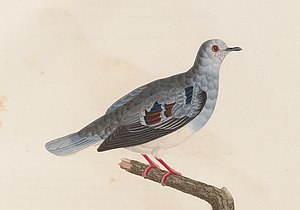Geoffroy's pigeon
| Geoffroy's pigeon | ||||||||||
|---|---|---|---|---|---|---|---|---|---|---|

Geoffroy's pigeon ( Claravis geoffroyi ) |
||||||||||
| Systematics | ||||||||||
|
||||||||||
| Scientific name | ||||||||||
| Claravis geoffroyi | ||||||||||
| ( Temminck , 1811) |
Geoffroy dove ( Claravis geoffroyi , Syn. : Claravis Godefrida ), also Purpurbindentäubchen or Spiegeltäubchen called, is a type of pigeon birds and belongs to the subfamily of American small pigeons .
Appearance
Geoffroy's pigeon reaches a body length of up to 23 centimeters. Geoffroy's pigeon is very similar in size and shape to the blue dove belonging to the same genus . Similar to this species, there is a noticeable gender dimorphism. The males have an overall blue-gray plumage, while the females are cinnamon brown.
The male's forehead, face and chest are whitish blue-gray. The plumage turns into a white-gray on the under tail-coverts. The top of the body is a little darker. The three rows of metallic dark spots on the wings are striking. The beak is dark gray. The feet are reddish. The female is cinnamon brown on the top of the body. The rows of spots on the wings are darker than those of the blue dove females. The underside of the body is a little lighter.
distribution and habitat
Geoffroy's pigeon occurs in southeastern Brazil, in eastern Paraguay and in northern Argentina. The habitat is dense stands of the bamboo genus Gadua in forests of the subtropical zone. Observations are available from the lowlands up to altitudes of 2,300 meters.
Way of life
Geoffroy's pigeon is a food specialist that lives mainly on the seeds of the two bamboo species Guadua chacoensis and Gadua trinii . As with many other bamboo species, these two species also bloom at very long intervals, but then in large areas at the same time. Geoffroy's pigeon is therefore forced to live nomadically, which makes efforts to preserve this species very difficult. Almost nothing is known about the reproductive habits of Geoffroy's pigeons. It is only certain that the clutch consists of two creamy white eggs.
Existence and endangerment
Geoffroy's pigeon, which was still relatively common in the 19th and early 20th centuries, is now considered extremely rare in the entire distribution area. The IUCN estimates the population at a maximum of 250 individuals and classifies the species in the category “ critically endangered ”. The cause of the decline is the clearing of forests in order to create settlements and plantations. This has reduced the occurrence of the bamboo thickets necessary for this species and increased the distance between the individual bamboo stands. The IUCN considers it possible that the habitat is now so fragmented that this species cannot survive.
supporting documents
Individual evidence
- ↑ a b BirdLife Factsheet (Accessed June 16, 2009)
- ↑ Gibbs, p. 347
literature
- David Gibbs, Eustace Barnes and John Cox: Pigeons and Doves - A Guide to the Pigeons and Doves of the World. Pica Press, Sussex 2001, ISBN 90-74345-26-3 .
- Gerhard Rösler: The wild pigeons of the earth - free living, keeping and breeding. M. & H. Schaper Verlag, Alfeld-Hannover 1996, ISBN 3-7944-0184-0 .
Web link
- Claravis geoffroyi inthe IUCN 2013 Red List of Threatened Species . Listed by: BirdLife International, 2013. Retrieved January 4, 2014.